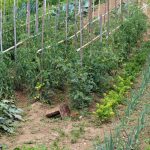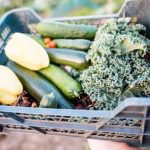Vertical gardening has become a popular and innovative way to cultivate plants, especially in urban environments where space may be limited. The concept of growing vegetables in a vertical garden involves utilizing vertical space to maximize the number of plants that can be grown in a small area. This method not only provides an efficient use of space but also offers numerous benefits such as improved air quality, enhanced visual appeal, and easy access for maintenance and harvesting.
When considering what vegetables can grow in vertical gardens, it is essential to choose the right varieties that are well-suited for this type of environment. Factors such as compact growth habits, lightweight foliage, and shallow root systems are important criteria to consider when selecting vegetables for vertical gardening. With careful planning and proper care, a wide range of vegetables can thrive in a vertical garden, providing an abundant and nutritious harvest.
In this article, we will explore the process of choosing the right vegetables for vertical gardening, including the criteria for selection and examples of vegetables that excel in this setting. Additionally, we will delve into the design and setup of vertical gardens, caring for vegetables in this unique environment, maintenance practices, creative utilization of vertical garden space, success stories of vegetable varieties that thrive in vertical gardens, and insights into the future potential of vertical gardening.
Whether you’re an experienced gardener looking to try something new or a beginner with limited gardening space, there’s valuable information here to help you embark on your own vertical gardening journey.
Choosing the Right Vegetables for Vertical Gardening
When choosing the right vegetables for vertical gardening, it’s important to consider certain criteria to ensure successful growth and harvest. The best vegetables for vertical gardens are those that are compact in size, have a manageable growth habit, and can thrive in containers or small spaces. Additionally, selecting vegetables that have a high yield or grow upwards, such as vining plants, is ideal for vertical gardening.
Some of the best vegetables for vertical gardens include tomatoes, cucumbers, peppers, lettuce, spinach, and herbs like basil and mint. These plants are well-suited for vertical gardening because they don’t require a lot of space for their root systems and can be trained to grow upwards with the help of trellises or support structures. Other examples of vegetables that thrive in vertical gardens are radishes, green beans, peas, and small varieties of squash and eggplant.
It’s also important to consider the specific needs of each vegetable when planning a vertical garden. Some may require more sunlight or water than others, so be sure to take these factors into account when choosing which vegetables to plant. By selecting the right vegetables for your vertical garden based on these criteria, you can maximize your space and achieve a bountiful harvest.
| Vegetables | Benefits |
|---|---|
| Tomatoes | Compact size and high yield |
| Cucumbers | Manageable growth habit and can be trained to grow upwards |
| Peppers | Thrives in containers or small spaces |
| Lettuce & Spinach | Compact size and low root system requirements |
Designing and Setting Up a Vertical Garden
When it comes to designing a vertical garden, the layout is crucial to ensure that all plants receive adequate sunlight and water. Consider the direction of the sun in your location and plan for taller plants to be placed at the back while shorter ones are in front. This will prevent overshadowing and allow for proper growth. Additionally, think about how you can maximize space by utilizing walls, fences, or specially designed vertical garden structures.
Choosing the Right Structure and Materials
There are various options for creating a vertical garden, from simple DIY projects using recycled materials to ready-made systems available on the market. Depending on your budget, available space, and aesthetic preferences, you can choose between modular planting systems, traditional trellises, or even living wall panels. Make sure to select materials that are durable and appropriate for outdoor use, as they will need to withstand the elements over time.
Tips for Optimal Plant Placement
Different vegetables have varying needs when it comes to spacing and support requirements. Before setting up your vertical garden, research the specific requirements of each vegetable you plan to grow. Some may need additional support like trellises or cages, while others may thrive when allowed to cascade down from higher shelves. Pay attention to plant heights and growth habits so that each one has enough room to flourish in its designated spot.
With these considerations in mind, you can design and set up a vertical garden that not only looks attractive but also provides an efficient growing environment for a wide variety of vegetables. By carefully planning the layout, selecting suitable structures and materials, and placing plants strategically, you can create a thriving vertical garden that yields an abundance of fresh produce throughout the growing season.
Caring for Vegetables in Vertical Gardens
Vertical gardens offer a unique way to grow vegetables in limited space, but they also require specific care and attention to ensure the plants thrive. Proper maintenance is essential for a successful vertical garden. One of the most important aspects of caring for vegetables in vertical gardens is ensuring they receive adequate water and irrigation.
Watering and Irrigation:
When it comes to vertical gardens, watering can be a bit more challenging than traditional gardens. With plants stacked on top of each other, reaching each one with a watering can or hose can be difficult. Drip irrigation systems are often recommended for vertical gardens as they deliver water directly to the base of the plant, ensuring that each one receives the necessary hydration.
Fertilization and Soil Maintenance:
In addition to watering, fertilization and soil maintenance are crucial for the health of vegetables in vertical gardens. Since these gardens often use containers or pockets, it’s important to regularly replenish the soil with nutrients through organic fertilizers or compost. This helps sustain healthy growth and abundant yields throughout the growing season.
Managing Pests and Diseases in a Vertical Garden:
Just like traditional gardens, vertical gardens are susceptible to pests and diseases that can wreak havoc on vegetable crops. Regularly inspecting plants for any signs of infestation or disease is key to preventing widespread issues. Utilizing natural pest control methods and practicing good gardening hygiene can help maintain a healthy environment for your vegetables.
Vertical Garden Maintenance
Pruning and Training Plants
In a vertical garden, it’s important to regularly prune and train your plants to encourage healthy growth and maximize space utilization. This may involve removing dead or yellowing leaves, as well as guiding the direction of vine-like plants to prevent overcrowding and promote air circulation.
Monitoring Plant Health
Regular monitoring of plant health is crucial for identifying any issues early on. Keep an eye out for signs of nutrient deficiencies, pest infestations, or diseases that may affect your vegetable crops. Addressing these issues promptly can help prevent them from spreading and causing significant damage.
Harvesting Vegetables From a Vertical Garden
Harvesting your vegetables at the right time is key to enjoying the fruits of your labor. Be sure to check your plants regularly for ripe produce, such as tomatoes, peppers, cucumbers, and leafy greens. Harvesting at the peak of freshness will reward you with delicious homegrown vegetables.
By paying attention to these aspects of vertical garden maintenance, you can help ensure the long-term success of your vertical gardening project and enjoy a bountiful harvest of fresh, homegrown vegetables.
Creative Ways to Utilize Vertical Garden Space
Vertical gardens offer a unique opportunity to not only grow vegetables, but also to creatively utilize vertical space for enhanced productivity and aesthetics. By incorporating innovative techniques and strategic planning, gardeners can make the most of their vertical garden space.
Companion Planting in a Vertical Garden
One creative way to maximize the use of vertical garden space is through companion planting. This practice involves growing different plant species together to provide mutual benefits such as pest control, pollination, and space utilization. In a vertical garden, tall-growing plants like tomatoes or pole beans can provide natural support for vining crops like cucumbers or squash. Additionally, planting herbs such as basil or oregano among vegetable crops can help deter pests and attract beneficial insects.
Utilizing the Vertical Space for Non-Edible Plants
In addition to growing vegetables, vertical gardens can be utilized to showcase ornamental plants and flowers. By incorporating flowering vines, trailing foliage, or decorative hanging baskets within the structure of a vertical garden, gardeners can create an eye-catching display that serves both aesthetic and functional purposes. This not only adds visual interest to the garden but also attracts pollinators and beneficial insects that contribute to overall garden health.
Incorporating Trellises and Other Support Structures
To further optimize vertical gardening space, integrating trellises and other support structures can expand the variety of vegetables that can be grown. Vine crops like peas, melons, and gourds thrive when provided with stable climbing supports. Additionally, trellises and arbors add dimensionality to the garden while creating opportunities for more efficient use of limited ground space.
By creatively utilizing vertical gardening space through companion planting, non-edible plant incorporation, and strategic support structures, gardeners can maximize the potential of their vertical gardens while exploring new possibilities for sustainable urban agriculture.
Success Stories
When it comes to vertical gardening, the types of vegetables that can thrive in this unique growing environment are a crucial factor to consider. Not all vegetables are well-suited for vertical gardens, so it’s important to choose varieties that will flourish in this setting. One key consideration is selecting plants that don’t require a lot of space for their root systems and can tolerate being grown upwards.
Some of the best vegetables for vertical gardens include leafy greens like lettuce, spinach, and kale, as well as compact herbs such as basil, parsley, and cilantro. These plants tend to have shallow root systems and can be easily grown in containers or hanging pouches on a vertical structure. Additionally, vining plants like tomatoes, cucumbers, and beans are excellent choices for vertical gardens because they naturally grow upwards with minimal support.
In terms of specific examples, cherry tomatoes are particularly well-suited for vertical gardens due to their compact size and ability to thrive in containers. Similarly, bush varieties of cucumbers or peas can be trained to climb up a trellis or other support system in a vertical garden. Overall, the key is to look for vegetable varieties that are adaptable to growing in confined spaces and can tolerate the upward growth patterns associated with vertical gardening.
| Vegetable Variety | Reasons for Excellence in Vertical Gardens |
|---|---|
| Lettuce | Shallow root system ideal for containers |
| Cherry Tomatoes | Compact size and ability to thrive in containers |
| Cucumbers (bush variety) | Can be trained to climb up trellises or other supports |
Final Thoughts
In conclusion, the future of vertical gardening looks promising as more people are looking for innovative ways to grow their own food in urban environments. With the rising popularity of sustainable and space-saving gardening methods, vertical gardening provides a viable solution for individuals with limited outdoor space. By utilizing vertical space, gardeners can grow a wide variety of vegetables, herbs, and even fruits in a compact and efficient manner.
The potential for vertical gardening to address issues such as food insecurity and environmental sustainability continues to drive interest in this method of cultivation. As urbanization increases and available land for traditional gardening diminishes, vertical gardens offer a practical solution for individuals to produce their crops while also beautifying their surroundings. Furthermore, the ability to incorporate companion planting and utilize the vertical space for non-edible plants makes this gardening technique versatile and appealing.
For those interested in venturing into vertical gardening, it is essential to explore the best vegetables for vertical gardens based on growing conditions, available space, and personal preferences. Additionally, proper planning, design, and maintenance are crucial factors in ensuring the success of a vertical garden.
With creativity and dedication, anyone can transform their living spaces into flourishing green oases that yield an abundant harvest of fresh produce. As more people embrace the benefits of vertical gardening, it undoubtedly holds great promise for sustainable food production in the future.
Frequently Asked Questions
What Vegetables Can You Grow in a Vertical Garden?
In a vertical garden, you can grow a variety of vegetables such as tomatoes, lettuce, peppers, spinach, kale, and even some root vegetables like radishes and carrots. The key is to choose plants that don’t require a lot of space for their roots.
What Plants Can I Put in a Vertical Garden?
When it comes to plants for a vertical garden, you have many options beyond just vegetables. You can grow herbs like basil, mint, rosemary, and cilantro. Flowers such as petunias, impatiens, and pansies also do well in vertical gardens, adding color and beauty to the space.
What Vegetables Can Grow in a Tower Garden?
Tower gardens are great for growing leafy greens like lettuce, spinach, and Swiss chard. They also work well for herbs such as basil, cilantro, and mint. Additionally, tower gardens are suitable for growing compact vegetables like cherry tomatoes and small peppers due to their vertical design that maximizes space.

If you’re looking to get into vegetable gardening, or are just looking for some tips on how to make your current garden better, then you’ve come to the right place! My name is Ethel and I have been gardening for years. In this blog, I’m going to share with you some of my best tips on how to create a successful vegetable garden.





